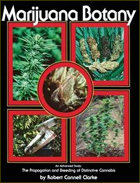
by Robert Connell Clarke
Layering
Layering is a process in which roots develop on a stem while it remains attached to, and nutritionally supported by the parent plant. The stem is then detached and the meristematic tip becomes a new individual, growing on its own roots, termed a layer. Layering differs from cutting because rooting occurs while the shoot is still attached to the parent. Rooting is initiated in layering by various stem treatments which interrupt the downward flow of photosynthates (products of photosynthesis) from the shoot tip. This causes the accumulation of auxins, carbohydrates and other growth factors.
Rooting occurs in this treated area even though the layer remains attached to the parent. Water and mineral nutrients are supplied by the parent plant because only the phloem has been interrupted; the xylem tissues connecting the shoot to the parental roots remain intact (see illus. 1, page 29). In this manner, the propagator can overcome the problem of keeping a severed cutting alive while it roots, thus greatly in creasing the chances of success.
Old woody reproductive stems that, as cuttings, would dry up and die, may be rooted by layering. Layering can be very time-consuming and is less practical for mass cloning of parental stock than removing and rooting dozens of cuttings. Layering, however, does give the small-scale propagator a high-success alternative which also requires less equipment than cuttings.

